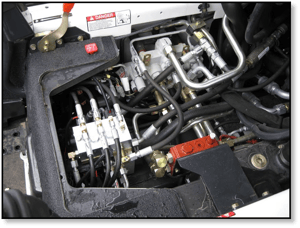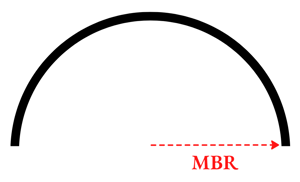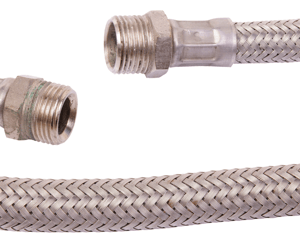The minimum bend radius is important in hydraulic layout, but what is the difference between static and dynamic bend radius?

Here are a few more Shop Talk Blog posts you might find helpful:
- 5 Things to Avoid Doing with Hydraulic Lines
- Hydraulic hose Failure
- Rebuilding a Rexroth Final Drive
Bend Radius
In hydraulics, the bend radius refers to the radius of a bend, and the minimum bend radius is how much something can be bent before it suffers damage. Bend radius isn’t specific to hydraulics, however: I first discovered bend radius in an old Machinery’s Handbook in a section dealing with sheet metal bending, but there are also bend radius rules for things like telecommunications cables.

Figure 1. The complexity of hydraulic systems for compact equipment can make it tricky to ensure that none of the hydraulic lines are bent too much.
In general, the purpose of having a minimum bend radius (MBR) is to ensure that something isn’t bent to the point that its useful life is shortened (like sheet metal) or that its functionality is compromised -- think breaking glass fibers in a fiber optic cable or broken wires in a network cable. And in hydraulics, it can be tricky to ensure that nothing is bent too much -- just look at Figure 1.
And for each of these applications (hydraulics, sheet metal, communications), there are guidelines to be followed. To use the guidelines for hydraulics, however, it is essential to be clear on the definition of bend radius.
Bend Radius
Here’s a general definition of bend radius as it relates to hydraulic hoses and lines:
Bend radius is the radius of a bent section of hose as measured to the innermost surface of the curved portion

Figure 2. Mininum bend radius for a hydraulic line.
Static Bend Radius
The static bend radius is the smallest radius that you can bend a hydraulic line without it kinking when it's bent/flexed into its fixed position. Put differently, it's the smallest radius that you can bend a hose, line, or tube without it getting kinked.
Dynamic Bend Radius
There’s also the dynamic bend radius that applies to hoses where flexing can occur. Like static bend radius, it is the smallest radius the hose can be bent without kinking but takes into account movement. Dynamic bend radius is used when you know that the hose may move during operation BUT applies more to flexible metal hoses (see Figure 3) than metal-reinforced rubber or polymer hoses. Hoses that move are usually subject to significant pressure changes (including pressure spikes), vibration, bending, or flexing.

Figure 3. Dynamic bend radius is important for flexible metal hoses subject to movement.
Why is dynamic bend radius so important for metal hoses? Metal is subject to fatigue failure, where it can fail at a much lower level of stress if that load varies over time.
Finding the Bend Radius
When the manufacturer provides a bend radius, it will usually be the static bend radius. However, if you have a flexible metal hose subject to any dynamic conditions, you need to use the dynamic bend radius. In that case, the minimum bend radius will be multiplied by a bend factor. The bend factor is a value between 1.1 to 1.5 and will be supplied by the manufacturer.
Conclusion
If you’re working with flexible metal hydraulic lines that will experience movement, you need to use the dynamic bend radius. The dynamic bend radius is the MBR multiplied by a bend factor, which you can get from the manufacturer.


